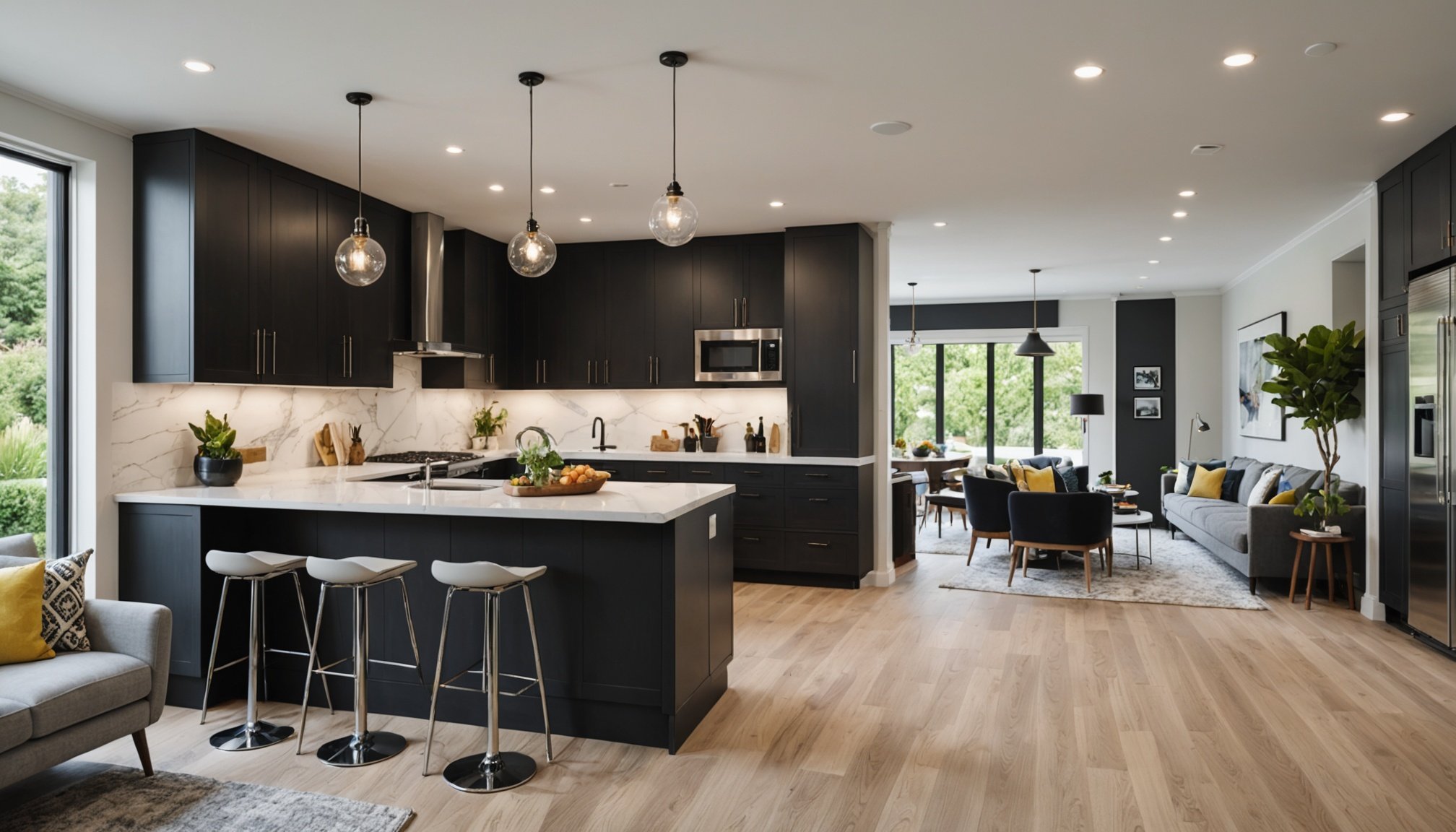Understanding Seamless Design Concepts
Incorporating seamless design into your home can transform disparate rooms into a cohesive space. This approach emphasizes the integration of spaces, ensuring a unified flow throughout the home. But what exactly defines seamless design, and why is it important in home aesthetics?
Seamless design is about creating harmony between different parts of your home. The main idea is to make rooms feel naturally connected, regardless of their separate functions or styles. This is achieved by blending elements in a way that makes transitions from one area to another effortless and visually pleasing.
Also to read : Designing an ideal farm-to-table kitchen: fresh ideas for eco-friendly living
Key Principles of Creating a Cohesive Environment
-
Consistency in Materials: Use similar materials, such as wood or metal, across different spaces to create visual continuity.
-
Open Layouts: Optimize spatial arrangements to encourage interaction and flow between areas. Keeping sightlines open can enhance connectedness.
In parallel : Revamp your contemporary kitchen with a chic coffee roasting station: essential tips for seamless integration
-
Colour Continuity: A unified colour palette ties different spaces together, promoting a harmonious and inviting atmosphere.
Successful integration examples abound, from open-concept kitchens extending into living rooms to uniform flooring that runs throughout multiple rooms. By adopting these principles, homeowners can craft spaces where movement and design harmoniously intersect, ensuring their entire home resonates with balance and purpose.
Choosing a Unified Color Palette
Selecting a color palette that seamlessly integrates your kitchen and living spaces is crucial for achieving design cohesion. Start by choosing a base of neutral tones, such as whites, greys, or beiges, which effortlessly unify different areas by providing a consistent backdrop. These hues allow you to introduce subtle accent colors for visual interest without disrupting harmony.
The role of neutral tones in creating cohesive spaces is significant; they act as a canvas for harmonious hues. To strengthen this effect, incorporate colors found in nature—a gentle green or soft stone could echo organic elements within your home’s surroundings, enhancing integration.
For a striking yet seamless transition, try complementing neutral tones with bold accents that recur throughout. This might mean using cushions, rugs, and art pieces echoing the same splash of color. Visual examples include pairing a neutral base with royal blue accessories to denote a modern vibe or opting for pastel accents to foster a tranquil atmosphere.
Ultimately, the key is to ensure these color choices are carefully curated to establish flow and unity. This deliberate selection enhances the aesthetic appeal, making various spaces feel like extensions of one another.
Selecting Functional Furniture
Choosing the right furniture is crucial for achieving seamless design in kitchen and living spaces. A significant factor to consider is selecting multifunctional furniture. These pieces not only provide style but also serve multiple purposes, making them ideal for small spaces. By considering pieces like an extendable dining table or a sofa bed, you enhance both flexibility and functionality in your home.
Furniture selection should focus on cohesive styling to maintain flow between areas. Opt for furniture pieces that match the overall aesthetics of both the kitchen and living room. This integration creates a harmonious look that makes transitions smoother. For instance, choosing bar stools that echo the design language used in the seating area enhances cohesion.
In crafting a mindful furniture arrangement, aim to promote flow and cohesion. Strategically placing furniture can facilitate natural pathways, directing movement between spaces effortlessly. Arrangements such as aligning chairs parallel to the sightline or using a kitchen island as a bridging element between zones exemplify effective strategies.
When done thoughtfully, furniture selection and arrangement can greatly influence the connectivity of your home’s core areas, ultimately fostering a more open and accommodating environment.
Effective Layout Strategies
Creating a layout design that seamlessly connects kitchen and living areas can elevate your home’s overall flow and aesthetic. Here’s how to achieve effective spatial arrangement and flow optimization:
Focus on the strategic arrangement of furniture and pathways to ensure optimal movement. Arranging furniture parallel to your sightline not only maintains openness but also directs movement fluidly. Use elements like kitchen islands or counters to bridge spaces functionally and visually. This encourages a unified experience without obstructing pathways.
Consider distinct zones for different activities, yet allow these areas to merge visually. For instance, position a dining table as a transition piece between the cooking space and the lounging area. This multifunctionality not only optimizes space but enhances the room’s utility.
Incorporate open layouts that encourage interaction and maintain a coherent design language. Case studies reveal that homes with such connected zones often feature fewer partitions, promoting an airy feeling. This approach is particularly effective in smaller homes where maximizing space is crucial.
By implementing these strategies, the layout can significantly influence how spaces relate to one another, fostering a harmonious and inviting home atmosphere.
Incorporating Decorative Elements
Decorative elements play a vital role in achieving a seamless connection between the kitchen and living spaces. By carefully selecting accessories, you can enhance the visual cohesion between these areas, making transitions smoother and more inviting.
When aiming for cohesive decor, focus on integrating elements that resonate with both spaces’ style and color palettes. Consider using artwork, vases, or textiles that echo the dominant colors or themes present in both rooms. This repetition fosters unity and flow, encouraging a harmonious experience throughout your home.
Purchasing or repurposing accessories that bridge the kitchen and living areas can add flair while maintaining consistency. For example, decorative bowls or centerpieces on countertops can mirror those on coffee tables, subtly linking the two spaces. Similarly, selecting cushions and throws that complement kitchen accents like backsplash tiles or cabinetry enhances seamless transitions.
Materials such as wood, metal, or glass can also unify the two areas. By featuring metallic finishes in both the dining area and living room fixtures or using similar wood tones for cabinetry and coffee tables, you create a cohesive decor narrative. These thoughtful touchpoints not only beautify your home but also reinforce its integrated design.
Utilizing Lighting to Enhance Cohesion
Incorporating the right lighting solutions is essential for fostering a seamless atmosphere between kitchen and living spaces. Thoughtfully chosen illumination not only enhances ambiance but also strengthens the visual connection between areas.
For achieving cohesive illumination, consider using a mix of ambient, task, and accent lighting. Ambient lighting, such as overhead fixtures, ensures a uniform spread of light throughout the space. Task lighting, like under-cabinet lights in the kitchen, provides focused illumination where needed. Accent lighting, such as wall sconces, helps to highlight architectural features and create visual harmony.
Types of lighting that work well in cohesive designs include pendant lights, which can act as focal points in open-concept kitchens and living areas. Recessed lights maintain a minimalistic look, providing clarity without intruding on the aesthetic. Use dimmable fixtures to adjust the mood according to different activities, enhancing the space’s versatility.
To incorporate lighting fixtures harmoniously, select designs that mirror other decorative elements. Coordinating materials, like metal in both light fixtures and furniture hardware, reinforces a unified look. Strategic lighting placement amplifies the sense of openness and connectivity, enriching your home’s overall design narrative.
Expert Insights and Real-Life Examples
In the world of interior design, expert opinions consistently emphasise the significance of seamless design in creating cohesive spaces. According to leading designers, seamless integration enhances flow and connectivity, making homes feel more inviting and functional. Design expert Sarah Johnson notes, “A unified home design not only increases visual appeal but also maximises space utility.”
Case studies of successful kitchen and living room integrations further highlight this concept. For instance, the open-concept home of Jones family showcases a harmonious blend of materials and colours, where a shared colour scheme and similar cabinetry styles create visual continuity. Such real-life examples inspire homeowners to adopt these strategies in their spaces.
Design inspirations often stem from mixing expert advice with homeowner preferences. One popular approach involves utilising multifunctional furniture and strategic lighting solutions to unify different areas. For instance, an island dividing the kitchen and living room can serve as both a seating area and storage, while pendant lights provide a cohesive illumination.
These lessons in seamless design demonstrate how thoughtful design choices lead to inviting and efficient spaces. By consulting experts and analysing successful implementations, homeowners can create environments that are both stylish and practical.











